About Us
News
Nippon Telegraph and Telephone East Corporation
NTT DOCOMO, INC.
NTT Communications Corporation
Nippon Telegraph and Telephone West Corporation
March 30, 2011
Damage and Restoration Status Regarding the Tohoku-Pacific Ocean Earthquake and Future Prospects
Due to the impact of the Tohoku-Pacific Ocean Earthquake that occurred on March 11, 2011, some of NTT Group’s services, including fixed-line and mobile communication services, remain unavailable, particularly in the Tohoku region. The entire group is currently devoting its efforts towards restoration, and we apologize for any inconveniences caused.
After the earthquake, facilities were damaged and commercial power supply was disrupted at exchange offices, among other things, impacting approximately 1.5 million circuits for fixed-line services, approximately 6,700 mobile base station equipment, approximately 15,000 circuits for corporate data communication services and others.
In accordance with its disaster prevention operation plans based on the Basic Act on Disaster Control Measures, NTT Group established the Disaster Countermeasures Office and over 10,000 people from NTT group companies across the nation have been making an all-out effort to restore the damaged communication facilities and services. Through such efforts as its provision of the Disaster Emergency Message Dial and the Disaster Message Board service, deployment of mobile base station vehicles (approximately 30 vehicles) and satellite mobile phones (approximately 870 handsets) and installation of special public telephones (approximately 2,300 telephones), NTT Group is making efforts to secure a means of communication for those who were affected by the earthquake.
As a result of these efforts, more than 90 percent of the affected exchange offices and mobile base station equipment have been restored and services are gradually recovering. Going forward, NTT Group is planning to have its exchange offices and base stations almost completely restored (except for certain areas where restoration is physically difficult, such as areas surrounding the nuclear power plant and areas with physically damanged roads, tunnels, etc.) by the end of April through, among others, renewal of power supplies and equipment and re-installing relay transmission lines, repair of relay transmission lines to mobile base stations, and area remedies for mobile phones using large zone schemes where a single station covers multiple stations.
With regards to the remaining areas, NTT Group will endeavor to prioritize the restoration of services in particular areas, such as municipalities and evacuation shelters, and improve the communication environment by, among other things, providing even more satellite mobile phones and other communication means.
Regarding corporate data communication services, approximately 90 percent have been restored to date. Submarine cables connecting Japan with the United States and other parts of Asia have been partially damaged, but NTT Group has been using various backup cable routes to maintain uninterrupted services, and there is currently no impact on its overseas communication services.
To support the affected people of the disaster, NTT Group is, among other efforts, providing its communication services free of charge, safety confirmation information of those affected, and company residences as living space for those impacted by the earthquake. NTT Group is working to gather donations from its customers and has decided to donate one billion yen. NTT Group will devote its full strength to support the victims of this disaster and the recovery of the stricken areas.
The following summarizes the damage done to NTT group companies and the efforts made towards restoration.
1. Damage and restoration status of Nippon Telegraph and Telephone East Corporation ("NTT East")
(1) Status of the impact on communication facilities
The current status of damage to the main communication facilities are as follows.
- [1] Relay transmission lines
- Disconnected in 90 routes
- [2] Exchange office building
- Demolished: 18 buildings
- Submerged: 23 buildings
- [3] Destruction by flood and collapse of telephone poles
- Approximately 65,000 poles (coastal region)
- [4] Submersion and physical damage to aerial cables
- Approximately 6,300 kilometers (coastal region)
(2) Restoration efforts on communication facilities (facilities within exchange offices, transmission lines between exchange offices)
[1] Efforts undertaken so far
The earthquake and tsunami disrupted commercial power supply and caused equipment failure in approximately 1,000 exchange offices. NTT East responded by deploying emergency batteries, emergency power generators and mobile power supply vehicles to provide power. However, some exchange offices remained inoperable, resulting in the disruption of a total of approximately 1.5 million circuits at maximum in telephone subscriber lines, ISDN and FLET’S Hikari (FTTH) services as of March 13.
Under these circumstances, NTT East has thus far, with the help of other NTT group companies and construction companies, mobilized a total of some 6,000 people to make an all-out effort to restore these services. By 1:00 p.m., March 28 (JST), approximately 95 percent of the exchange offices have been restored along with the recovery of commercial power supply, leaving 55 dysfunctional exchange offices and approximately 110 thousand affected circuits remaining to be restored.
Number of circuits with communication service failures

Note: Figures exclude failures due to circuit disruptions between customer homes and NTT East exchange offices.
[2] Status of the impact on exchange offices with discontinued services
The damage and restoration status of the exchange offices with discontinued services (55 buildings) as of March 28 are as follows.
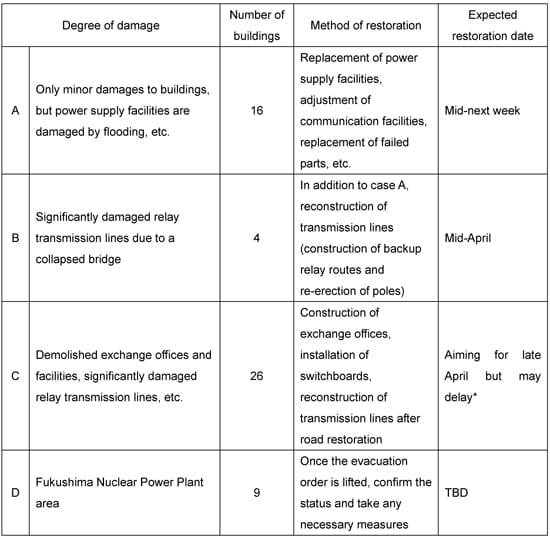
* Details will be announced separately once the timing of restoration is confirmed.
Also, if the degree of damage is assessed as "C" and municipal government office buildings are located within the area of an applicable exchange office, as a general rule, stopgap repair measures will be implemented within a week and public administration and other important circuits will be restored (5 buildings).
Forecasted number of days needed for restoration of services in exchange offices with discontinued services
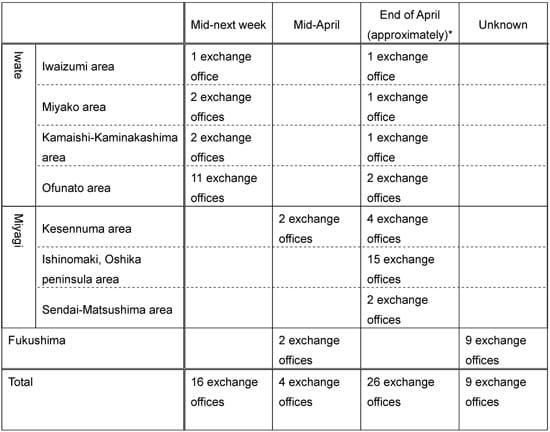
Note: The end of April is targeted, but there may be a delay depending on the situation. Details will be announced separately once the timing of restoration is confirmed.
(3) Efforts to restore communication facilities (outdoor facilities)
Telephone poles, communication cables and other facilities outside NTT exchange offices suffered significant damage due to the earthquake and tsunami. Immediately after the earthquake, it was difficult to inspect these facilities as restricted areas were set and traffic controls applied, but as these restrictions were rescinded, NTT East has been confirming the conditions in these areas using helicopters and other means, and will direct its efforts towards service restoration going forward in accordance with the damage situation and the reconstruction of the cities.
(4) Organization for restoration, etc.
After the earthquake struck, NTT East established a Disaster Countermeasures Office in its headquarters office, as well as Disaster Countermeasure Offices in the stricken prefectures, thus creating an organizational structure capable of close collaboration 24-hours-a-day. With a team of approximately 5,000 people, these Disaster Countermeasure Offices then commenced efforts to understand the extent and nature of the damage and initiate restoration.
Among others, in Iwate, Miyagi and Fukushima, the three prefectures where the damage was the greatest, a wide-area support structure was built, with staff dispatched from headquarters and other branch offices, as well as receiving assistance from NTT West and other group companies. Currently, a team of approximately 6,000 people are handling the restoration efforts.
(To address full restoration of services, it is planned that telecommunication construction companies will be added to the team to reinforce these efforts going forward.)
(5) Efforts to support the affected people
[1] Provision of Disaster Emergency Message Dial, etc.
Since the earthquake, NTT East has been providing safety confirmation services "Disaster Emergency Message Dial 171" and "Disaster Emergency Broadband Message Board (Web 171)" to be used by those affected by the earthquake. As of 1:00 p.m. on March 28 (JST), "171" has been used approximately 3.17 million times cumulatively and "Web 171" approximately 0.24 million times cumulatively.
[2] Deployment of free public telephones, etc.
To secure a means of communication for people affected by the earthquake, NTT East has installed in 738 locations 2,308 special public telephones that are available for use free of charge (as of 12:00 noon, March 28 (JST)). This accommodation has been implemented in almost all locations requested by local governments.
Also, NTT East made the existing public telephones in the six prefectures located within the Tohoku region available for use free of charge immediately after the earthquake. At 7:00 p.m. on March 11 (JST), 122,000 public telephones across the entirety of Eastern Japan were made available for use free of charge. Currently, following the lifting of call restrictions, public telephones remain free in Iwate, Miyagi and Fukushima.
[3] Waiver of telephone charges, etc.
For customers who were actually unable to use their telephones or broadband services due to the earthquake, the basic charges for those periods, as well as service relocation costs when moving in to temporary housing, will be waived and the payment deadline for telephone and other charges will be extended.
[4] Others
- Installation of free Internet connection stations at evacuation shelters, etc.
Free Internet connection stations have been installed at evacuation shelters in 12 prefectures (138 stations) (of which 63 stations have Wi-Fi environment).
- Taking messages from people in damaged areas
NTT East staff members deliver messages, on behalf of affected people, to their families, and if the family members are away from home, NTT East registers their messages on the Disaster Emergency Message Dial on their behalf.
2. Damage and restoration status of NTT DOCOMO, INC. ("DOCOMO")
(1) Current status of communication facilities
With regard to base station equipment, the earthquake and tsunami caused disruptions to the commercial power supply and equipment failure, primarily in the Tohoku and the Kanto Koshinetsu regions. As of 5:00 p.m. on March 12 (JST), 6,720 stations were inoperable.
DOCOMO, with the help of other NTT group companies and construction companies, mobilized a total of some 4,000 people to make an all-out effort to restore its communication services. By 2:00 p.m., March 28 (JST), approximately 90 percent of the stations have been restored along with the recovery of the commercial power supply, leaving 690 stations remaining to be restored.
Many of the base station equipment yet to be restored include those that have suffered entrance circuit disruptions, submersion and physical damage of equipment, and those that are difficult to access due to the nuclear power plant incident.
Number of base station equipment with disrupted services

Note: Actual amounts are shown for figures equal to or less than 20. Figures more than 20 have been rounded to the nearest ten.
For restoration going forward, DOCOMO has formulated a restoration plan for 375 base station*, equivalent to approximately 530 base station equipment with disrupted services (FOMA) in the three prefectures, Iwate, Miyagi and Fukushima. As for the 307 base stations in the Fukushima prefecture, excluding the 68 stations that are difficult to access due to the nuclear power plant incident, DOCOMO is endeavoring to restore a total of 248 stations (150 stations by mid-April and another 98 stations by late April) through restoration of transmission lines using optical fiber, micro-wireless circuits and satellite circuits and utilization of large zone schemes (a method to cover areas normally covered by multiple stations by utilizing a single station) by installing base stations at mountaintops and other locations.
As for the remaining 59 stations, due to delays in restoration from physical damage to mountain areas and facilities within road tunnels, among other factors, satellite mobile phones and other devices will be provided at meeting places/centers.
For specific details on the restoration plans, we intend to make the information available on the "Restoration Area Maps" in early April.
* Base station: A base that has base station equipment installed. There may be instances where there are multiple base station equipment (2 GHz and 800MHz, etc.) installed on a single base station.
Number of base stations expected to be restored (FOMA) and the expected restoration dates

Note: Figures exclude 68 base stations located within a 30 kilometer range from the Fukushima Nuclear Power Plant.
After the earthquake struck, communications traffic increased dramatically and it was difficult for calls to get through. To address this, DOCOMO implemented maximum capacity restrictions on voice calls of 80 percent (90 percent in certain areas) around the Tohoku and Kanto regions to ensure that important communications could go through. In Miyagi prefecture, DOCOMO temporarily implemented maximum capacity restrictions on packet transmissions of 30 percent immediately after the earthquake, however, there has been no restrictions since.
With regard to DOCOMO Shops, immediately after the earthquake, 159 out of 195 shops in the Tohoku region were forced to close temporarily, but as a result of the efforts to reopen quickly, all shops, other than those in buildings that were severely damaged or those within the evacuation area around the Fukushima Nuclear Power Plant, have reopened. As of March 28, 21 DOCOMO Shops still remain closed.
Restoration status to date in the areas that were mainly impacted
- Ishinomaki/Oshika peninsula area
- Service mostly restored in the central part of Ishinomaki-shi and Higashi-Matsushima-shi
- Service not yet restored in the eastern parts of Ishinomaki-shi and Onagawa-cho
- Kesennuma area
- Service mostly restored in Kesennuma-shi and the central part of Minami-Sanriku-cho
- Sendai-Matsushima area
- Service mostly restored in Sendai-shi, Tagajo-shi, Shiogama-shi and Matsushima-cho
- Ofunato area
- Service mostly restored in Ofunato-shi, and the central part of Rikuzen-Takata-shi
- Miyako area
- Service mostly restored in the central part of Miyako-shi
- Service not yet restored in the northern coastal regions
- Iwaizumi area
- Service mostly restored in the central part of Iwaizumi-cho
- Service not yet restored in the coastal regions
- Kamaishi-Kaminakashima area
- Service mostly restored in Kamaishi-shi and the central part of Otsuchi-cho
- Service not yet restored in the surrounding areas of Kamaishi-shi and Otsuchi-cho
(2) Organization for restoration, etc.
Immediately after the earthquake struck, DOCOMO established a Disaster Countermeasures Office in its headquarters office and the Tohoku Regional Office, thus creating an organizational structure capable of close collaboration 24-hours-a-day. These Disaster Countermeasure Offices then commenced efforts to understand the extent and nature of the damage and initiate restoration.
In Iwate, Miyagi and Fukushima, the three prefectures where the damage was the greatest, DOCOMO headquarters and branch offices, as well as group companies, are cooperating to the utmost in endeavors to restore services as quickly as possible.
(3) Efforts to support the affected people
[1] Provision of Disaster Message Board service
To provide people affected by the earthquake and its aftermath with a means of communication, DOCOMO has been providing a "Disaster Message Board service" since immediately after the earthquake. In order to enable even more people to use this service as a means of communication with those affected, the regions eligible to post messages were expanded to cover the entire nation on March 17, and starting March 18, in addition to posting messages using i-mode, posting of messages from smartphones was also enabled. As of 12:00 midnight on March 28 (JST), the number of messages posted reached approximately 3.79 million.
[2] Addressing areas where mobile phones cannot be used
For areas where mobile phones cannot be used, DOCOMO has deployed approximately 30 mobile base station vehicles in efforts to secure communications. Further, to secure communication for the people affected by the earthquake, DOCOMO is renting to local administrative agencies and installing at evacuation shelters approximately 870 satellite mobile phones, approximately 1,440 mobile phones and approximately 180 tablet PCs, and has also established approximately 210 stations where mobile phones can be recharged for free using multi-chargers, solar chargers and AC adaptors. (As of 1:00 p.m., March 28 (JST))
[3] Release of Restoration Area Maps
For Iwate, Miyagi and Fukushima prefectures, which suffered the greatest damage from the earthquake, "Restoration Area Maps", which enable one to confirm such details as areas where FOMA service is available, areas that have been restored or are planning to be restored through the use of mobile base station vehicles, locations where satellite mobile phone and free recharging services are available and DOCOMO Shops’ store information, as well as conduct searches using municipality names, were newly released on March 20. Furthermore, for specific details on the restoration plans, we intend to make the information available on the Restoration Area Maps in early April.
[4] Launch of charity drive website for the affected areas
In order to support the affected areas, DOCOMO launched a website to collect donations from its customers. The collected contributions will be donated to a specified non-profit corporation, Japan Platform (the total donations made as of March 28 amounted to 751,315,192 yen).
[5] Refund of charges
For customers living in the areas where DOCOMO’s communication facilities were unavailable* due to failures caused by the Tohoku-Pacific Ocean Earthquake, DOCOMO will refund basic monthly fees for the periods when the service was not available.
* Customers who have subscriber addresses or billing addresses in those areas.
<Donation methods>
By "DOCOMO mobile remittance service" (from March 14)
By purchase of "Charity Content (standby displays)" (from March 14)
By "DOCOMO Points" (from March 19)
By "DCMX" (from March 24)
[6] Other
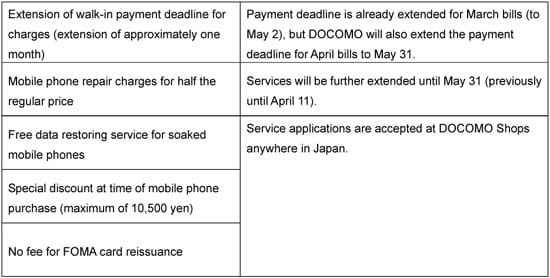
3. Damage and restoration status of NTT Communications Corporation ("NTT Com")
(1) Current status of communication facilities
Due to the earthquake, the relay network and other networks in the Tohoku region were damaged, affecting telephone and Internet connection services. However, this is gradually recovering as NTT Com has restored its facilities and has been using other backup cable routes. Meanwhile, services remain unavailable where access lines and customers’ facilities, etc. have been affected.
Regarding corporate data communication services, such as IP-VPN and e-VLAN, a maximum of approximately 15,000 circuits in the Tohoku region were not available, but the relay network is now restored. Due to damaged access lines and customers’ facilities, etc., however, approximately 1,600 circuits are yet to be restored as of March 28.
Submarine cables connecting Japan with the United States and other parts of Asia have been partially* damaged, but NTT Com has been using other backup cable routes to maintain uninterrupted services, and there is currently no impact on its overseas communication services (overseas data communication service, overseas internet, etc.).
The data centers were not affected.
* Damaged submarine cables (sections)
Japan-US (Japan ~ U.S.), APCN2 (Japan ~ China/Korea), China-US (Japan ~ U.S.), PC-1 (Japan ~ U.S.)
(2) Organization for restoration, etc.
Immediately after the earthquake struck, NTT Com established a Disaster Countermeasures Office in its headquarters office, thus creating an organizational structure capable of close collaboration 24-hours-a-day. The Disaster Countermeasure Office then commenced efforts to understand the extent and nature of the damage and initiate restoration.
A team of approximately 600 people was formed to handle the restoration efforts.
(3) Efforts to support the affected people
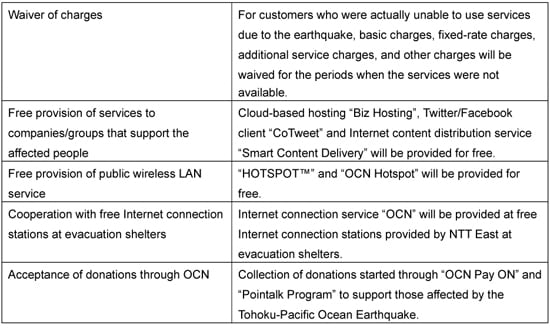
4. Support status of Nippon Telegraph and Telephone West Corporation ("NTT West")
Immediately after the earthquake struck, telephone calls to some parts of Eastern Japan, primarily the affected areas, became difficult, but this was resolved by March 12. The day after the incident, NTT West promptly deployed mobile power-supply vehicles to secure the power supply at communication facilities, and assisted in setting up special public telephones using portable satellite mobile phone and other equipment to secure a means of communication for the affected people. At the same time, NTT West continued to work at on-site surveys and restoration of communication cables, etc. with the aim of restoring customer circuits. To date, approximately 1,000 employees have provided this support.

* The number of people in the table indicates a gross number of people, including standby workers.
5. Major initiatives by other group companies
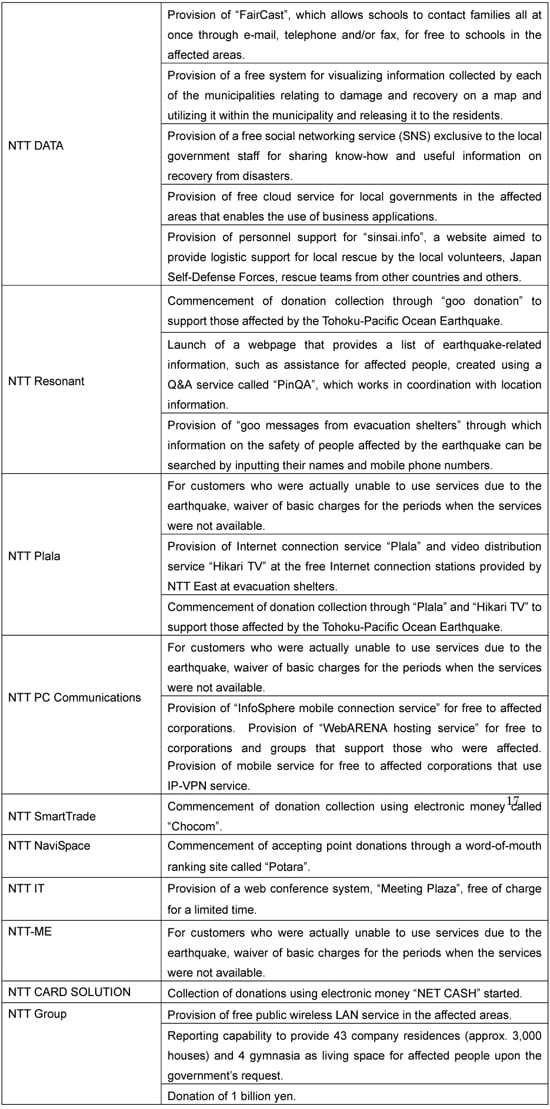
6. Future forecasts
For the latest developments, please visit NTT group companies’ websites from the following link: http://www.ntt.co.jp/topics/20110316/index.html#news.
The damage and impact of this earthquake on NTT’s consolidated business results is currently unknown. We will make a separate announcement if we expect a material impact on our consolidated business results.

 EN
EN

